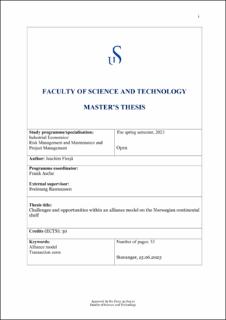| dc.description.abstract | This thesis will investigate how the Norwegian oil and gas industry changed their perception of what a client-supplier relationship is in recent years. As the industry has faced a number of challenges, increased cooperation between independent companies has been one attempt to address the uncertainty caused by the challenges. This has given the rise to a strategy that is well known in global manufacturing, the creation of alliances.
The thesis investigates how traditional strategic alliances works including key success factors, challenges, and opportunities of the new way of working. What is needed for an alliance to be successful? What makes an alliance sustainable? Is it mutually beneficial? Why try to make an alliance? To answer these questions information was gathered from AkerBP as well as the research literature on alliances. Presenting theory about alliances and alliance transaction costs in conjunction with examples from the subsea alliance a basis was formed.
Based on the collected material it is clear that an alliance can be beneficial for all parties involved, but that is no guarantee for success. An alliance requires hard work to form, hard work to sustain and hard work to be a success. The opportunities of an alliance are there but one needs to be aware of the pitfalls. It was shown by comparing theory that the subsea alliance had taken experience from other alliance research. Several of the same success factors of alliances is identical to the values and operation of the subsea alliance.
Through the work on the thesis there was two reoccurring factors that would give opportunities and supress challenges. The first being that all parties embraced the same values and communicate them clearly. Secondly, to avoid big internal economical inequity and keep working in the same direction. If these two measures are controlled and understood by management within an alliance it increases the likelihood of success. | |
